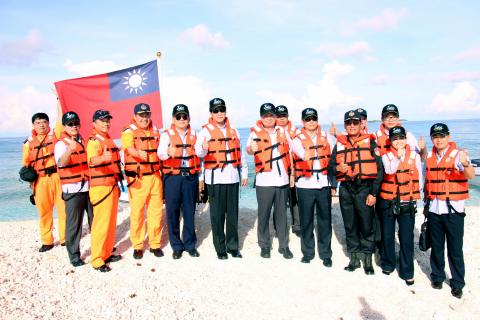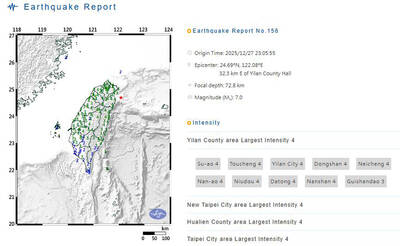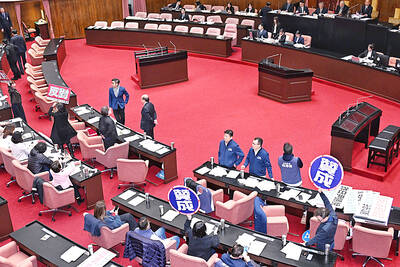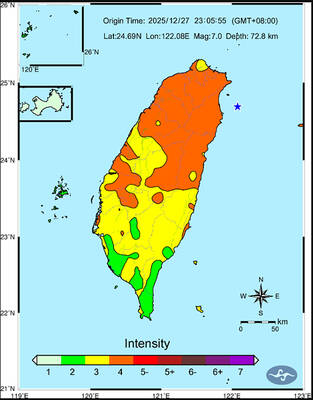The government yesterday said that it does not recognize or accept a ruling by an international arbitration panel that it could hear a case brought by the Philippines against China over disputed territory in the South China Sea.
The Philippines has not invited the Republic of China (ROC) to participate in its arbitration with China, and the arbitration tribunal has not solicited the ROC’s views, the Ministry of Foreign Affairs (MOFA) said in a statement.
“Therefore, the arbitration does not affect the ROC in any way, and the ROC neither recognizes nor accepts related awards,” it said.

Photo: CNA, courtesy of the Coast Guard Administration
The ministry’s statement came after the Permanent Court of Arbitration in the Netherlands on Thursday ruled that it has jurisdiction to hear the case, in which the Philippines argues that China’s “nine-dash line” territorial claim over South China Sea waters is unlawful under the UN Convention on the Law of the Sea (UNCLOS).
The statement seemed to indicate a stronger stance from the ministry than its initial response a day earlier, when it said the ROC’s determination to defend its sovereignty over four island chains in the South China Sea is not open to question and that it is closely following the developments in the case and would take measures as necessary.
The Philippines filed the case before the tribunal in The Hague in 2013 to seek a ruling on its right to exploit the South China Sea waters within its 200-nautical mile (370km) exclusive economic zone as allowed under the UN convention.
Taiwan is taking an interest in the case because it is one of the countries that claim all or parts of the South China Sea. Other claimants are Brunei, Malaysia, the Philippines and Vietnam.
Taiwan controls one of the Pratas Islands (Dongsha Islands, 東沙群島) and one of the largest of the Spratly Islands (Nansha Islands, 南沙群島) — Itu Aba (Taiping Island, 太平島).
In a statement, the ministry reiterated Taiwan’s stance on the South China Sea, saying that from the perspective of history, geography and international law, the Spratly Islands, Paracel Islands (Xisha Islands, 西沙群島), Macclesfield Bank (Zhongsha Islands, 中沙群島) and Pratas Islands in the region, as well as their surrounding waters, “are an inherent part of ROC territory and waters.”
“As the ROC enjoys all rights to these islands and their surrounding waters in accordance with international law, the ROC government does not recognize any claim to sovereignty over, or occupation of, these areas by other countries, irrespective of the reasons put forward or methods used for such claim or occupation,” it said.
Also, the South China Sea islands were first discovered, named and used, as well as incorporated into national territory, by the Chinese, the ministry said.
The San Francisco Peace Treaty of 1952 and the Treaty of Peace between the ROC and Japan, which was signed in the same year, as well as other international legal instruments, reconfirm that the islands and reefs in the South China Sea occupied by Japan were returned to the ROC, it added.
The ROC moved its seat of government to Taipei after Nationalist forces led by Chiang Kai-shek (蔣介石) were defeated by the Chinese communists in the Chinese Civil War in 1949.
Another point the ministry made in the statement was that ROC forces began to garrison Taiping Island in 1956, it said.
“From legal, economic and geographic perspectives, Taiping Island indisputably qualifies as an ‘island,’ according to the specifications of Article 121 of the United Nations Convention on the Law of the Sea, and can sustain human habitation and economic life of its own; it is thus categorically not a ‘rock’ under the same article,” it said.
Although Taiwan is not a contracting party to the UNCLOS, the ministry urged countries involved in the South China Sea dispute to respect the provisions and spirit of the UN Charter and the UNCLOS, and to exercise restraint, safeguard peace and stability in the region, uphold the freedom of navigation and overflight through the region, refrain from taking any action that might escalate tension and resolve disputes peacefully.

A magnitude 7.0 earthquake struck off Yilan at 11:05pm yesterday, the Central Weather Administration (CWA) said. The epicenter was located at sea, about 32.3km east of Yilan County Hall, at a depth of 72.8km, CWA data showed There were no immediate reports of damage. The intensity of the quake, which gauges the actual effect of a seismic event, measured 4 in Yilan County area on Taiwan’s seven-tier intensity scale, the data showed. It measured 4 in other parts of eastern, northern and central Taiwan as well as Tainan, and 3 in Kaohsiung and Pingtung County, and 2 in Lienchiang and Penghu counties and 1

FOREIGN INTERFERENCE: Beijing would likely intensify public opinion warfare in next year’s local elections to prevent Lai from getting re-elected, the ‘Yomiuri Shimbun’ said Internal documents from a Chinese artificial intelligence (AI) company indicated that China has been using the technology to intervene in foreign elections, including propaganda targeting Taiwan’s local elections next year and presidential elections in 2028, a Japanese newspaper reported yesterday. The Institute of National Security of Vanderbilt University obtained nearly 400 pages of documents from GoLaxy, a company with ties to the Chinese government, and found evidence that it had apparently deployed sophisticated, AI-driven propaganda campaigns in Hong Kong and Taiwan to shape public opinion, the Yomiuri Shimbun reported. GoLaxy provides insights, situation analysis and public opinion-shaping technology by conducting network surveillance

‘POLITICAL GAME’: DPP lawmakers said the motion would not meet the legislative threshold needed, and accused the KMT and the TPP of trivializing the Constitution The Legislative Yuan yesterday approved a motion to initiate impeachment proceedings against President William Lai (賴清德), saying he had undermined Taiwan’s constitutional order and democracy. The motion was approved 61-50 by lawmakers from the main opposition Chinese Nationalist Party (KMT) and the smaller Taiwan People’s Party (TPP), who together hold a legislative majority. Under the motion, a roll call vote for impeachment would be held on May 19 next year, after various hearings are held and Lai is given the chance to defend himself. The move came after Lai on Monday last week did not promulgate an amendment passed by the legislature that

AFTERMATH: The Taipei City Government said it received 39 minor incident reports including gas leaks, water leaks and outages, and a damaged traffic signal A magnitude 7.0 earthquake struck off Taiwan’s northeastern coast late on Saturday, producing only two major aftershocks as of yesterday noon, the Central Weather Administration (CWA) said. The limited aftershocks contrast with last year’s major earthquake in Hualien County, as Saturday’s earthquake occurred at a greater depth in a subduction zone. Saturday’s earthquake struck at 11:05pm, with its hypocenter about 32.3km east of Yilan County Hall, at a depth of 72.8km. Shaking was felt in 17 administrative regions north of Tainan and in eastern Taiwan, reaching intensity level 4 on Taiwan’s seven-tier seismic scale, the CWA said. In Hualien, the